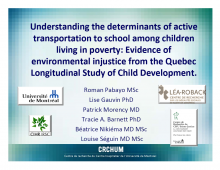We are pleased to announce an exciting new alliance between Active Living Research and GP RED to co-host and coordinate...
Understanding the Determinants of Active Transportation to School among Children Living in Poverty

Presentation at the 2010 Active Living Research Annual Conference
Background:
Concern has been raised among public health researchers and practitioners regarding the increase in prevalence of physical inactivity among children. A concurrent public health concern pertains to the high rate of collisions between pedestrians and motor vehicles in urban areas. Active Transportation (AT) such as walking and cycling to and from school are opportunities for children to be physically active. Poverty has been shown to be a determinant of both AT and pedestrian injuries with children from low SES backgrounds being more likely to live in areas fraught with motor vehicle collisions but also more likely to walk to school. Yet these associations have not been examined simultaneously.
Objectives:
To further explore the determinants of AT and the extent to which AT can be considered safe or unsafe, we examined the combined influence of poverty and dangerousness of the neighborhood environment on the likelihood of AT among a population-based birth cohort of children throughout the early school years.
Methods:
The sample comprised 1492 children that were part of the Quebec Longitudinal Study of Child Development (QLSCD), a birth cohort established in 1998 by the Direction Santé Québec of the Institut de la statistique du Québec. Data were collected through structured interviews in the home with the person most knowledgeable about the child's health (the mother for almost 98% of participants). The current analyses are based on data collected when the children were in kindergarten, grade one, and grade two. Parents were asked how their child usually gets to school. Responses were dichotomized to active (walking/bicycling) or inactive (school bus, public transit, is driven, or multiple modes). Poverty was measured according to the Low Income Cut-Offs (LICO) from Statistics Canada. Household income levels below the LICO threshold were categorized as insufficient income and thus living in poverty. Two types of measures were used to assess neighborhood dangerousness. First, parents were asked if their neighborhood was excellent, good, average, bad, or very bad for raising their children. Second, in a subsample consisting of children living on the Island of Montreal, ambulance report data were used to compute the density of pedestrian-vehicle collisions (range=0 to 28) and of auto accidents (range=0-239). These estimates were linked to data from children in the QLSCD by matching of postal codes. A participant's area of residence was classified as being dangerous if the postal codes had a pedestrian collision density greater than or equal to 1 (the 65th percentile) or the auto accident density was greater than 5 (the 70th percentile). Growth curve analyses were conducted to determine the combined effect of poverty and neighborhood dangerousness on the likelihood of AT. All analyses controlled for sex.
Results:
At age 6, insufficient household income (OR=2.0, 95% CI: 1.4, 2.8) and living in a perceived bad or very bad neighborhood for raising children (OR=1.5, 95% CI: 1.0, 2.0) were predictive of greater likelihood of using AT to school over time. When including children living in urban areas of Quebec, insufficient household income (OR=2.1, 95% CI:1.4,3.0) and living in a perceived bad or very bad neighborhood for raising children were each predictive of greater likelihood of using AT to school over time. However, restricting the sample to children living in Montreal, only insufficient household income was significantly associated with AT to school (OR=2.8, 95% CI: 1.5, 5.3). When adding road danger indicators in this sub-sample of children, insufficient household income (OR=2.3, 95% CI: 1.1, 4.5) and high automobile accident density (OR=2.6, 95% CI: 1.3, 5.5) were predictive of greater likelihood of using AT to and from school over time. Similarly, in a separate model, insufficient household income (OR=2.1, 95% CI: 1.1, 4.4) and high pedestrian-vehicle collision density (OR=2.4, CI: 1.3, 4.6) were predictive of greater likelihood of using AT to and from school across time.
Conclusions:
Insufficient household income, unfavorable perception of the neighborhood for raising children, and living in areas with high accident density are predictors of using AT to school across time. Since AT is most likely to be practiced among children living in poverty and because of evidence that AT is more likely to occur in unsafe environments, many children are experiencing a form of environmental injustice. Public health interventions aimed at providing safe routes to school are urgently required for children living in poverty and in neighborhoods where there are more motor vehicle collisions.
Support:
Research funded by the Canadian Institutes of Health Research (CIHR - Grant number 00309MOP-123079) and by the Institut de la statistique du Québec, Direction Santé Québec. RP is a Canada Graduate Scholarships Doctoral Award recipient from the Canadian Institutes of Health Research (CIHR)-Public Health Agency of Canada (CGD-81009). LG holds a CIHR/CRPO (Centre de recherche en prevention de l’obésité) Chair in Applied Public Health on Neighbourhoods, Lifestyle, and Healthy Body Weights. TAB holds a CIHR new investigator award.
STAY UP TO DATE
RECENTLY ADDED TOOLS & RESOURCES
MOVE! A BLOG ABOUT ACTIVE LIVING
The "Active Living Conference" aims to break down research and practice silos and...







